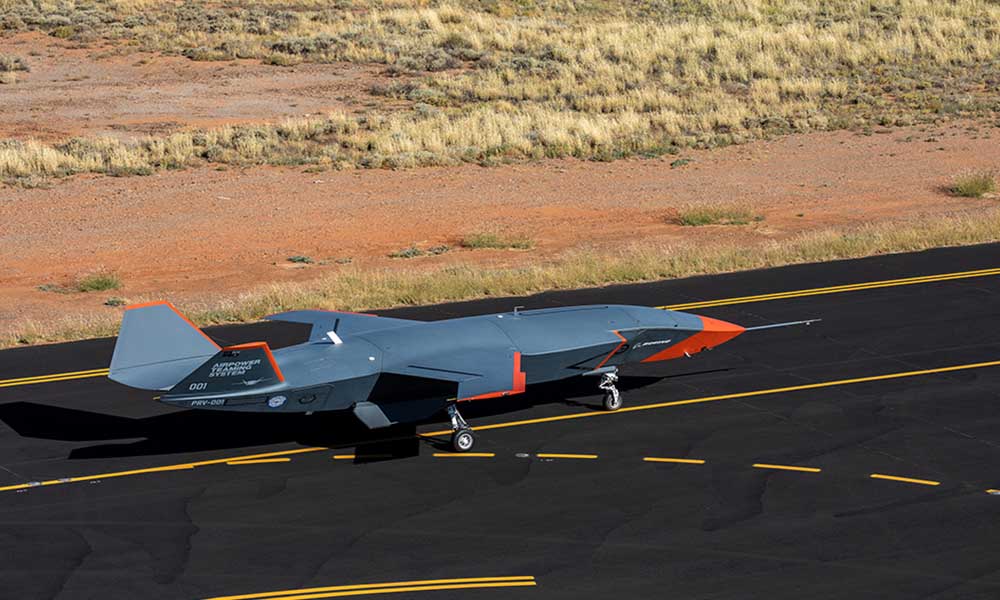Defence
Boeing to Develop AI-Powered Lethal Fighter Jets for US Defense

Boeing has embarked on a groundbreaking journey to develop a fleet of lethal, AI-piloted fighter aircraft for the United States military. According to the report, from DailyMail.
These “un-crewed” jets, officially dubbed the MQ-28 Ghost Bats, are designed to operate autonomously, guided by sophisticated artificial intelligence. The ambitious project envisions thousands of these AI-driven aircraft in the skies, sparking both excitement and concern about the implications of such technology.
UAE suspended talks over Multi billion dollar F-35 deal
Currently, Boeing’s working prototypes of the Ghost Bat, being developed in both the US and Australia, boast impressive capabilities.
At 38 feet in length, each drone can fly more than 2,300 miles and is equipped with artificial intelligence to operate independently. The aircraft also features roughly 53 cubic feet of storage capacity within its nose for interchangeable payloads, allowing it to carry an array of bombs and munitions, including potentially multiple tactical nuclear weapons.
While the Ghost Bats represent a significant leap forward in military technology, critics argue that these plans raise pressing questions about public safety, national security, and the ethical use of taxpayer funds. The concern stems from the potential for machines to select and strike targets without direct human intervention, which could fundamentally change the nature of warfare.
Air India to Enhance Long-Haul Travel with A350s as Competition Increases
The Pentagon estimates that each AI-controlled drone will cost approximately $30 million, but the final version is still open to bids from Boeing’s competitors, with a longer timeline extending into 2029 and beyond.
The US Air Force has requested $557 million for the fiscal year 2025 to develop and test its AI fighter program, with the ultimate goal of securing a multibillion-dollar contract to build a fleet of 1,000 AI jets. The urgency behind Boeing’s project stems from the United States’ drive to maintain an edge over China in the race to integrate AI into weapon systems

Defence
Russia’s NV.17 Hybrid Helicopter Aims to Balance Light and Heavy Helicopter Needs

As Western sanctions continue to impact Russia’s aviation sector, the country is making significant strides in advancing its domestic aerospace capabilities.
Despite the ongoing challenges, Russia has unveiled the Heliburo HB.17, a cutting-edge hybrid-powered medium-class helicopter that promises to reshape both commercial and military aviation.
The helicopter is currently in the technical design phase, with plans for its first flight slated for 2027. This marks a major step forward in Russia’s efforts to modernize its aviation fleet and reduce reliance on foreign technology.
This country tops visa rejections in the popular Schengen countries
The HB.17 is designed as a versatile, multi-role aircraft, capable of performing a wide range of functions. It is built to handle cargo transport, passenger carriage, reconnaissance, and close air support missions. With its robust design and flexible capabilities, the HB.17 is expected to meet the needs of both military and commercial operators, offering a solution for missions requiring a greater capacity than light helicopters but avoiding the limitations of larger aircraft.
One of the most innovative features of the HB.17 is its hybrid power plant. This combination of conventional and electric technologies enhances fuel efficiency, allowing the helicopter to stay airborne for up to seven hours without needing to refuel.
This extended operational endurance makes the HB.17 particularly well-suited for long-duration missions, providing a significant advantage over traditional helicopters. Additionally, the HB.17 will be equipped with modern avionics, ensuring advanced navigation, communication, and operational capabilities.
Qatar Airways Cargo and MASkargo Launch New Strategic Partnership
The HB.17 is positioned to compete with other medium-class helicopters such as the Kamov Ka-60/62 and the Mil Mi-38. However, its hybrid powerplant and modern avionics set it apart, offering a more efficient and technologically advanced alternative.
Its multi-role versatility, combined with its fuel efficiency and cutting-edge systems, gives it a competitive edge in the evolving aviation landscape. The introduction of the HB.17 follows recent reports of Russia receiving a new batch of armored vehicles from the UAE-based Streit Group.
Russia has traditionally focused on producing helicopters for defense purposes, but this time, it appears to be venturing into the civilian helicopter market with the HB.17.
This, along with the ongoing development of the HB.17, reflects Russia’s continued efforts to modernize its military assets and increase its self-reliance, even as sanctions continue to pressure its defense and aerospace sectors.
As Russia faces mounting geopolitical challenges, the HB.17 stands as a symbol of resilience, technological innovation, and determination to maintain its military and aviation capabilities.
-

 Aviation2 months ago
Aviation2 months agoMicrosoft Flight Simulator Raises $3 Million to Bring Back the An-225 Mriya
-

 Airlines2 months ago
Airlines2 months agoQatar Citizens Can Travel to the United States Without a Visa
-

 Aviation2 months ago
Aviation2 months agoQatar Airways bans these new Electronic Devices on plane
-

 Airlines2 months ago
Airlines2 months agoJapan Airlines Rolls Out Free Domestic Flights to International Passengers
-

 Travel2 months ago
Travel2 months agoQatar Airways Launches Four Additional Flights from Amsterdam
-

 Defence2 months ago
Defence2 months agoWhich Country Has the Largest Fleet of Fighter Aircraft?
-

 Airport2 months ago
Airport2 months agoWestern Sydney Airport Welcomes Its First Plane After 6 Years of construction
-

 Airlines4 days ago
Airlines4 days agoDAMAC Air: Dubai’s New Luxury Airline Offers Free Flights for Registration








